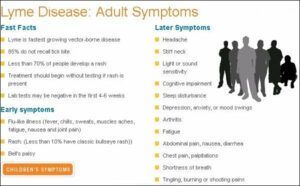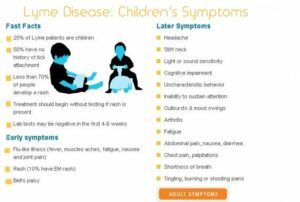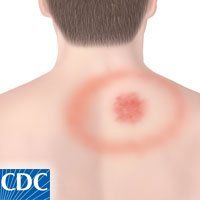Lyme Disease Symptoms
Lyme disease can potentially be misdiagnosed so it is important to be aware of the signs in order to reach the proper diagnosis.
Symptoms of early localized Lyme disease (Stage 1) begin days or weeks after infection. They are similar to the flu and may include:
- General ill-feeling
- Body-wide itching
- Chills
- Fever
- Headache
- Light-headedness or fainting
- Muscle pain
- Stiff neck

**There may be a “bull’s eye” rash, a flat or slightly raised red spot at the site of the tick bite. Often there is a clear area in the center. It can be quite large and expanding in size. This appears in most cases, but not all. Lyme Disease Symptoms may come and go. if left untreated, Lyme disease can spread to the brain, heart, and joints.
Symptoms of early disseminated Lyme disease (Stage 2) may occur weeks to months after the initial tick bite. They may include:
- Paralysis or weakness in the muscles of the face
- Muscle pain and pain or swelling in the knees and other large joints
- Heart problems, such as skipped heartbeats (palpitations)
Symptoms of late disseminated Lyme disease (Stage 3) can occur months or years after the initial infection. The most common Lyme Disease symptoms are muscle and joint pain. Other symptoms may include:
- Abnormal muscle movement
- Muscle weakness
- Numbness and tingling
- Speech problems
Less common signs and symptoms
Several weeks after infection, some people develop:
- Heart problems, such as an irregular heartbeat (heart problems rarely last more than a few days or weeks)
- Eye inflammation
- Liver inflammation (hepatitis)
- Severe fatigue
If you’ve been bitten by a tick and experience some of these Lyme Disease Symptoms, you should see a doctor
Some important things to remember are:
- Only a minority of deer tick bites leads to Lyme disease
- The longer the tick remains attached to your skin, the greater your risk of getting the disease
- If you think you’ve been bitten and experience signs and symptoms of Lyme disease, particularly if you live in an area where Lyme disease is prevalent, contact your doctor immediately
- Treatment for Lyme disease is most effective if begun early
**See your doctor even if symptoms disappear!!
It’s important to consult your doctor even if signs and symptoms disappear. The absence of symptoms does not mean the disease is gone. Ticks also can transmit other illnesses, such as babesiosis and Colorado tick fever which should be diagnosed and assessed by a healthcare professional.
Adult Lyme Symptoms
Fast Facts
- Lyme is fastest growing vector-borne disease
- 85% do not recall tick bite
- Less than 70% of people develop a rash
- Treatment should begin without testing if rash is present
- Lab tests may be negative in the first 4-6 weeks
**Your doctor may want you to have a blood test to confirm that the rash is actually a Lyme rash. People with early Lyme disease do not develop the antibodies necessary for the diagnostic tests for several weeks, and, early testing can give false negative results because of this. Although all medical treatment has some risk, treatment with antibiotics is relatively safe. Waiting for test results gives the spirochetes additional time to invade your body. Your doctor should explain the risks so you can make an informed choice.

Early localized stage (3-30 days post-tick bite)
- Red, expanding rash called erythema migrans (EM)
- Fatigue, chills, fever, headache, muscle and joint aches, and swollen lymph nodes
Some people may get these general symptoms in addition to an EM rash, but in others, these general symptoms may be the only evidence of infection.
Some people get a small bump or redness at the site of a tick bite that goes away in 1-2 days, like a mosquito bite. This is not a sign that you have Lyme disease. However, ticks can spread other organisms that may cause a different type of rash. For example, Southern Tick-associated Rash Illness (STARI) causes a rash with a very similar appearance.

- Rash occurs in approximately 70-80% of infected persons1 and begins at the site of a tick bite after a delay of 3-30 days (average is about 7 days).
- Rash gradually expands over a period of several days, and can reach up to 12 inches (30 cm) across. Parts of the rash may clear as it enlarges, resulting in a “bull’s-eye” appearance.
- Rash usually feels warm to the touch but is rarely itchy or painful.
- EM lesions may appear on any area of the body.

Early disseminated stage (days to weeks post-tick bite)
Untreated, the infection may spread from the site of the bite to other parts of the body, producing an array of specific symptoms that may come and go, including:
- Additional EM lesions in other areas of the body
- Facial or Bell’s palsy (loss of muscle tone on one or both sides of the face)
- Severe headaches and neck stiffness due to meningitis (inflammation of the spinal cord)
- Pain and swelling in the large joints (such as knees)
- Shooting pains that may interfere with sleep
- Heart palpitations and dizziness due to changes in heartbeat
Many of these symptoms will resolve over a period of weeks to months, even without treatment2.However, lack of treatment can result in additional complications, described below.
Late disseminated stage (months to years post-tick bite)
Approximately 60% of patients with untreated infection may begin to have intermittent bouts of arthritis, with severe joint pain and swelling. Large joints are most often affected, particularly the knees3. Arthritis caused by Lyme disease Symptoms manifests differently than other causes of arthritis and must be distinguished from arthralgias (pain, but not swelling, in joints).
Up to 5% of untreated patients may develop chronic neurological complaints months to years after infection4. These include shooting pains, numbness or tingling in the hands or feet, and problems with short-term memory.
